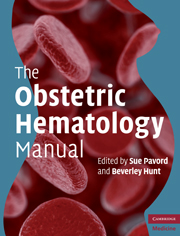Book contents
- The Obstetric Hematology Manual
- The Obstetric Hematology Manual
- Copyright page
- Contents
- Contributors
- Preface
- Acknowledgments
- Section 1 Cellular changes
- Section 2 Feto-maternal alloimmune syndromes
- Section 3 Thromboembolism and anticoagulation
- Chapter 7 Acute management of suspected thromboembolic disease in pregnancy
- Chapter 8 Thromboprophylaxis
- Chapter 9 Prosthetic heart valves
- Chapter 10 Management of anticoagulants at delivery
- Section 4 Thrombophilia and fetal loss
- Section 5 Hemorrhagic disorders
- Section 6 Microangiopathies
- Section 7 Malignant conditions
- Index
Chapter 8 - Thromboprophylaxis
from Section 3 - Thromboembolism and anticoagulation
Published online by Cambridge University Press: 06 December 2010
- The Obstetric Hematology Manual
- The Obstetric Hematology Manual
- Copyright page
- Contents
- Contributors
- Preface
- Acknowledgments
- Section 1 Cellular changes
- Section 2 Feto-maternal alloimmune syndromes
- Section 3 Thromboembolism and anticoagulation
- Chapter 7 Acute management of suspected thromboembolic disease in pregnancy
- Chapter 8 Thromboprophylaxis
- Chapter 9 Prosthetic heart valves
- Chapter 10 Management of anticoagulants at delivery
- Section 4 Thrombophilia and fetal loss
- Section 5 Hemorrhagic disorders
- Section 6 Microangiopathies
- Section 7 Malignant conditions
- Index
Summary
- Type
- Chapter
- Information
- The Obstetric Hematology Manual , pp. 99 - 108Publisher: Cambridge University PressPrint publication year: 2010

